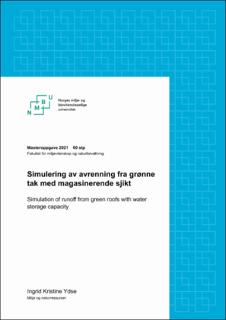| dc.contributor.advisor | Kitterød, Nils-Otto | |
| dc.contributor.advisor | Nilsen, Vegard | |
| dc.contributor.author | Ydse, Ingrid Kristine | |
| dc.date.accessioned | 2022-03-28T11:32:55Z | |
| dc.date.available | 2022-03-28T11:32:55Z | |
| dc.date.issued | 2021 | |
| dc.identifier.uri | https://hdl.handle.net/11250/2987969 | |
| dc.description.abstract | Vann er livsviktig for mennesker. Likevel kan vann i stor hastighet og stor mengde gjøre mye skade, og i verste fall koste liv. Urbanisering og endringer i nedbørsfelt gjør at overvann må tas hensyn til i planleggingen av fremtidens byer. Undergrunnen er en endelig ressurs og muligheten til å bruke tak for å fordrøye og tilbakeholde vann tar overvannshåndteringen til nye høyder. Overordnet er målet med denne oppgaven å sammenligne hvordan ulike modeller simulerer avrenning fra et grønt tak med magasinerende sjikt. Utgangspunktet er en fysisk modell av et grønt tak med magasinerende sjikt på 50 m^2 med 150 mm finknust LECA (lightweight expanded clay aggregate) og 40 mm sedummatte. Det ble gjennomført forsøk med både stasjonær og ikke-stasjonær strømning. Observasjonene legger grunnlaget for kalibrering av parametere og til sammenligning med simuleringene. Avrenning ble simulert med ikke-stasjonær numerisk modell i en dimensjon (1D) og dybdeintegrert i to dimensjoner (2D).
1D ikke-stasjonær numerisk modell simulerer avrenning fra et grønt tak godt. Den gjennomsnittlige absolutte feilen er 0.0011 l/s for et tak på 50 m^2 og utgjør 2 % av gjennomsnittlig avrenning fra mettet porøst medie. 1D numerisk modell simulerer avrenning med tilsvarende presisjon som Distance Distribution Dynamics (DDD-modellen) hvis Nash-Sutcliffe efficiency og Kling-Gupta efficiency benyttes som valideringskriterier. Utregnet porevannshastighet fra 1D numerisk modell er imidlertid bedre fysisk fundert. Medianverdien fra 1D numerisk modell var 1.5*10^-4 m/s som er omtrent 7 ganger høyere enn DDD-modellen simulerer. Hydraulisk ledningsevne ble estimert til 1.23 * 10^-3 m/s med analytisk løsning for stasjonær strømning i akvifer med hellende bunn. Inversmodellering med analytisk løsning for ikke-stasjonær strømning viser at avrenning er mer sensitiv til endring i mettet hydraulisk ledningsevne enn drenerbar porøsitet.
Målet med grønne tak som overvannstiltak er å forsinke flomtopper og redusere mengden avrenning. Modeller som simulerer den hydrologiske effekten er et verktøy i planleggingen av fremtidens byer. Det konkluderes med at kalibrering av mettet hydraulisk ledningsevne med analytisk løsning og bruk av numerisk modell i en dimensjon er en god måte å simulere avrenning fra et grønt tak med magasinerende sjikt. | en_US |
| dc.description.abstract | Water is essential for life. Nevertheless, water in high speed and big amount can cause damage, and in worst case cost human life. Urbanization and change in catchment area does that storm water needs to be taken into consideration in planning future cities. The subsoil is a limited resource and the possibility to use roofs as detention and retention of storm water will take storm water management to reach a new high. Primary the aim of this master’s thesis is to compare how different models simulates runoff from a green roof with water storage capacity. A physical model of a green roof with water storage capacity in 50 m2 with 150 mm crushed LECA (lightweight expanded clay aggregate) and 40 mm sedum. It was accomplished experiments with steady state and transient ground water flow. The observations is the basis for calibration of parameters and to comparison with simulations. Runoff was simulated with transient numerical model in one dimension (1D) and depth integrated in two dimensions (2D).
1D transient numerical model simulates runoff from a green roof in a good way. The mean absolute error is 0.0011 l/s for a roof of 50 m2 and form 2 % of mean runoff from saturated porous media. 1D numerical model simulates runoff with correspondingly precision as Distance Distribution Dynamics (DDD-model) if Nash-Sutcliffe efficiency and Kling-Gupta efficiency is used as validation criteria. Calculated pore water velocity from 1D numerical model is however better physically based. The median value was 1.5_10−4 m/s which is 7 times as high as the simulation from the DDD-model. Hydraulic conductivity is estimated to 1.23 _ 10−3 m/s with analytical solution for steady state flow with sloping aquifer. Inverse modelling with analytical solution for transient flow show that runoff is more sensitive for change in saturated hydraulic conductivity than drainable porosity.
The purpose of green roofs as a storm water management strategy is detention and retention of runoff. Models that simulates the hydrological performance of green roofs is a tool in the planning of the future cities. The conclusion is that calibration of saturated hydraulic conductivity with analytical solution and use of numerical model in one dimension is a good way to simulate runoff from a green roof with water storage capacity. | en_US |
| dc.language.iso | nob | en_US |
| dc.publisher | Norwegian University of Life Sciences, Ås | en_US |
| dc.rights | Attribution-NonCommercial-NoDerivatives 4.0 Internasjonal | * |
| dc.rights.uri | http://creativecommons.org/licenses/by-nc-nd/4.0/deed.no | * |
| dc.title | Simulering av avrenning fra grønne tak med magasinerende sjikt | en_US |
| dc.title.alternative | Simulation of runoff from green roofs with water storage capacity | en_US |
| dc.type | Master thesis | en_US |
| dc.description.localcode | M-MINA | en_US |

